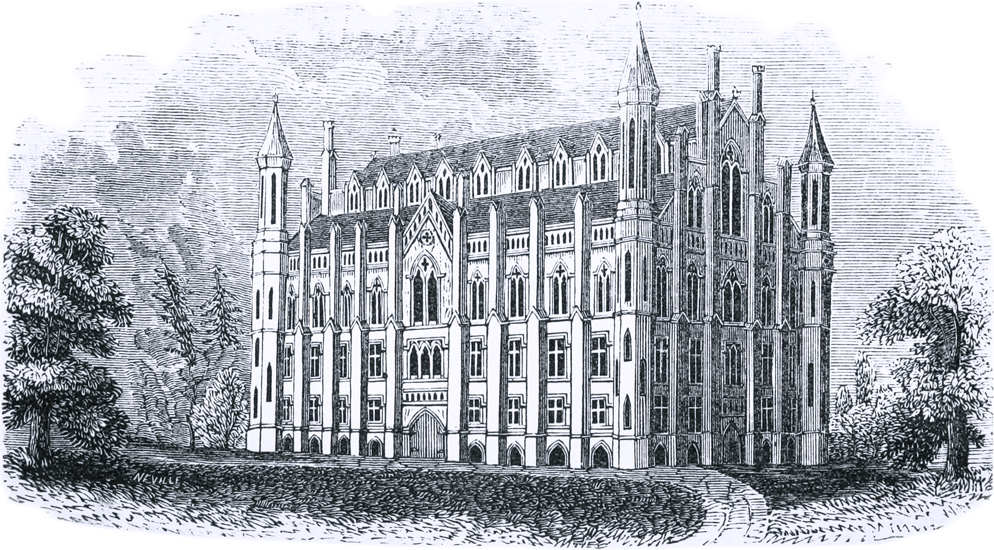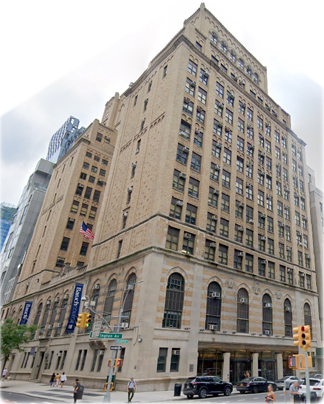
Free Academy of the City of New York
The Free Academy of the City of New York (now the City University of New York - CUNY), was founded in 1847. An Act from the New York State Legislature, authorizing the Board of Education of the City and County of New-York to establish a Free Academy, passed on May 7. This was one of the first institutions of free public higher education in the United States. Townsend Harris (1804-1878), considered the founding father, was the president of the city’s Board of Education from 1846 to January 1848, then replaced by Robert Kelly.
On September 1, 1847, the board of education resolved to purchase ten lots on the east side of Lexington Avenue, at the southeast corner of East 23rd Street as the site for the Free Academy. Foundations of the Free Academy neo-Gothic building began to be laid by January 3, 1848. It was designed by architect James Renwick Jr. (1818-1895), who also designed the Grace Church, consecrated in 1846, and the St. Patrick's Cathedral, constructed from 1858 to 1888. The Free Academy building was 80 feet wide, by 125 feet deep, and was intended to accommodate 1,000 pupils. Inside there were drinking fountains supplied from the Croton Reservoir, a chapel for 1,300 persons and a library.
The Free Academy opened on January 27, 1849 (Saturday). The entering class consisted of 143 boys between the ages of 13 and 15. Another 59 applicants were admitted later that year. The stuccoing of the walls of the neo-Gothic building was completed by the middle of the same year.
On March 30, 1866, the New York Free Academy was made a body corporate with the title of “The College of the City of New York.” It was christened as such on April 30, along with a funeral procession for the Free Academy. New buildings opened on the site in November 13, 1883 to house the chemistry and physics departments
In December 1895, the city began to acquire title to the land on Amsterdam Avenue, between 138th and 141st streets, where the new College was built. George B. Post was the architect. The groundbreaking for the new City College campus was in 1903. The five large neo-Gothic buildings of the College of the City of New York, at 138th to 141st streets, Amsterdam Avenue and St. Nicholas Terrace were completed in 1906 and formally dedicated on May 14, 1908.
On May 7, 1907, the faculty and students of the City College took formal leave of their old building on Lexington Avenue and took possession of their new group of buildings on St. Nicholas Terrace. The old City College was unoccupied in the following years. In the early 20th century most part of the façades were covered by climbing plants.
The United States entered the World War I in the late 1917. On May 14, 1918 an experimental kitchen opened as a food laboratory in the eastern wing of the old City College. After the war, the City College used the old building as a branch known as the “Commerce Building”, which housed the School of Business and Civic Administration.
The historic neo-Gothic building was demolished in 1927 and a 16-story school building at 17 Lexington Avenue, was constructed on the site in 1928-1929. In 1953, the school was renamed after philanthropist and financier Bernard M. Baruch. In 2005, the building was renamed Lawrence and Eris Field Building after philanthropist Lawrence N. Field and his wife.


The Baruch College, 16-story building at 17 Lexington Avenue, completed in 1929, on the site of the old Free Academy (Google Street View, 2022).
The Free Academy, rear view. Engraving by Neville published in the Francis's Guide to the Cities of New-York and Brooklyn, and the vicinity, 1854 (copyright 1853).

|
Copyright © Geographic Guide - Universities of New York City. |